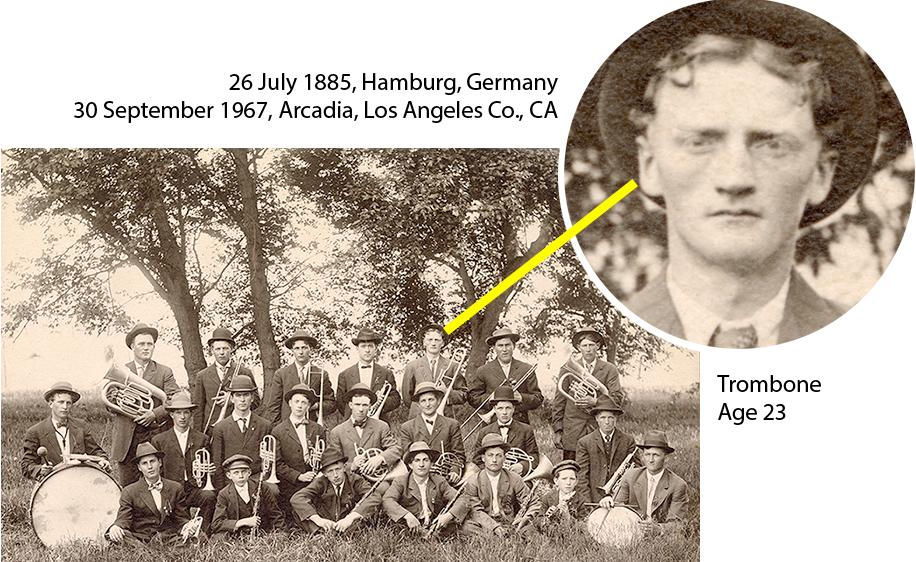
Primary sources cannot confirm the details about John Fred Rohlf’s birth and emigration from Germany, partly because of the difficulty in disambiguating several John Rohlfs in this time and place. On census records, he reported his immigration year as either 1891 or 1895. He listed his parents as William Rohlf and Edith Myers, but their birth and death dates are unknown.
John Rohlf was naturalized in October 1900 in Grundy Center, Grundy County, Iowa. Grundy is adjacent to Tama County, a prominent locus of German immigrants in the last decades of the 19th century. The date of his further travel to northwest Iowa and O’Brien County is uncertain, but by the time of the June 1909 Calumet German Band photo, he was living alone in the town of Paullina, just a few miles to the northwest of Calumet, in Union Township, working as a carpenter.
Seven years after the band photo, he married Katherine May Hilton (1885-1930) on 22 July 1916 in Spirit Lake (Dickinson County). Katherine had been born in Sanborn, to the north of Paullina and Calumet in O’Brien County; her parents were Frank Hilton (1857-1898), also born in Sanborn, and Anna Estella Tifft (1859-1914), who had been born in Kentucky.
At the time of their marriage in 1916, John was working as a carpenter in Spencer (Clay County), not far from Spirit Lake where the couple was married. His World War I registration in September 1918, as well as the 1920 census records, show the couple as continuing to live in Spencer. Incidentally, John’s carpentry work had apparently taken a physical toll. On the World War I draft documentation, the registrar noted “one finger gone,” which would have been grounds for a medical exemption from normal military service under the Selective Service Act of 1917.
The couple relocated to California around 1922. There they lived in Pasadena, about 11 miles northeast of downtown Los Angeles, where John continued to work as a carpenter, building houses. The entire Southern California region was undergoing rapid growth in the 1920s, and home construction would have been a thriving occupation for someone with John’s skills.(1) The Rohlfs appeared to move with some frequency; their addresses in the 1928, 1929, and 1931 Pasadena city directories were different but all within a few miles of one another.
In early 1930, Katherine Hilton Rohlf took ill, and she died on 4 June 1930, at age 45. There is no indication in public records that the couple had children.
Although John can be seen as continuing to live in Pasadena at least into 1931, by 1935 he was living in San Francisco, and at that time he was remarried, to Irna Leanor “Lena” Tucker (1894-1983), a native Californian and the daughter of George Lowen Tucker (1868-1913) and Evangeline Jeanette “Nettie” Harwood (1870-1964). Lena Tucker had been previously married to Vernon E. Alfter (1898-1978).
The move of John and Lena to Northern California seems to have been temporary; by 1940, the couple had moved back to Los Angeles County and the town of Arcadia, near Pasadena, where Lena Tucker had been born. At this time John was the foreman of a home-building construction crew. There the couple remained for the rest of their lives.
Irrespective of their marriage compatibility and mutual interests (for instance, they both were active in the Odd Fellows and its affiliated Rebekah Lodge for women, and they both attended the Unity Church in the nearby town of Alhambra), they seem not to have agreed on every issue of the day. In the 1950 California voter registration records for Precinct No. 5 in Arcadia, John Rohlf is registered as a Republican, and Irna Rohlf as a Democrat.
John Fred Rohlf died on 30 September 1967, in Arcadia, at age 82. His widow Irna “Lena” Tucker Rohlf lived until 1983.

Subscribers to Ancestry.com may wish to further explore some family connections of John Rohlf by accessing an Ancestry profile page (within the context of a “Mugge Family Tree”).
Connection to Other Band Members
In the case of John Fred Rohlf, there are no known family or other close connections to other Calumet German Band members.
Footnote
(1) Although Pasadena was already well established as a popular resort community, especially once it became connected in 1887 to the transcontinental Atchison, Topeka, and Santa Fe Railroad, the larger region was constrained by the lack of reliable water supplies to support a more expanded urban population. But construction of the Los Angeles Aqueduct, which began in 1908, reached the San Fernando Valley in late 1913. Thereafter the region experienced rapid real estate development. Vast expanses that had previously been Mission lands, ranchos, and agricultural areas (fruit and nut tree groves) were turned quickly into new towns and suburban housing tracts.
